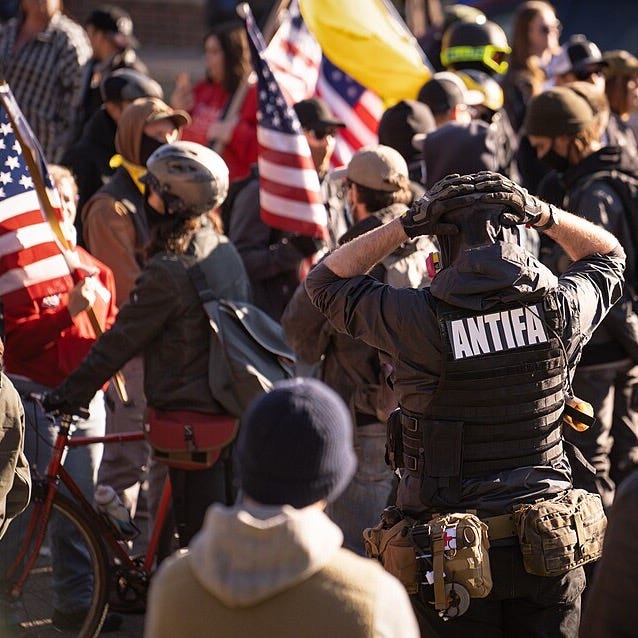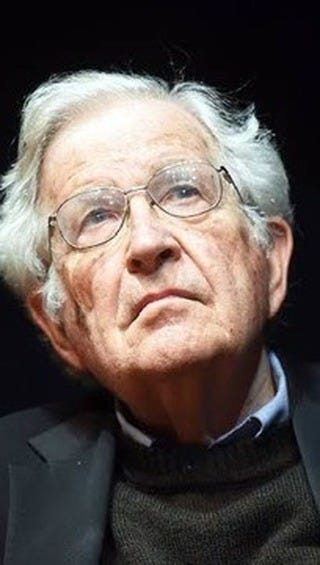Antifa is not an organization, it's worse
But Trump still cannot formally label them a terrorist group
Last month, President Trump issued an executive order designating Antifa as a domestic terrorist organization. Critics have correctly noted that the president doesn’t actually have the power to officially label any domestic group that way. Going further, some have argued that Antifa isn’t an organization at all, and a growing chorus of left-wing voices is gaslighting the nation by claiming Antifa doesn’t even exist.
“There’s no Antifa. This is an entirely imaginary organization. There is not an Antifa.” – Jimmy Kimmel “Antifa are things that are thought up.” – Whoopi Goldberg “There’s no organization called Antifa.” – Wisconsin congressman Mark Pocan “Nobody is a member of Antifa because it doesn’t exist.” – historian Timothy Snyder
The reason the president cannot label a domestic group as a terrorist organization is not because there’s no terrorism in the country. We experienced 310 terrorist attacks from 2015 to 2019 alone. Rather, the reason is because the Constitution doesn’t allow the government to keep an official blacklist of U.S. groups. Doing so would amount to the government declaring certain associations off-limits, which would discourage people from joining or supporting those groups. But under the First Amendment, Americans have the right to associate with any group they please, even unpopular ones, whether it be the Aryan Freedom Network or Hizb ut-Tahrir America. There is no criminal charge known as “domestic terrorism,” just as there is no criminal charge known as “gang activity.” It’s not illegal to be a member of the 18th Street Gang or MS-13. Members of such groups only run into problems if and when they break the law, and when they do, they are charged as individuals for those specific crimes, such as homicide or assault. But when it comes to foreign groups, that’s a different story.

In 1995, Timothy McVeigh and Terry Nichols bombed the Alfred P. Murrah Federal Building in Oklahoma City, killing 168 people, including 19 children, and injuring 684 others. The attack exposed profound weaknesses in how the U.S. handled terrorist threats, creating the necessary political momentum in Congress and the Clinton administration to tighten anti-terrorism laws. The following year, the Antiterrorism and Effective Death Penalty Act was created, expanding the federal government’s authority to investigate and prosecute terrorism, and creating a legal mechanism for the State Department to designate groups as foreign terrorist organizations (FTOs) under Section 219 of the Immigration and Nationality Act. In 1997, under this framework, the State Department labeled 28 groups as FTOs, including Hamas and Hezbollah. Before this, the term “terrorist group” was not a formal legal category, so there was no clear framework to impose sanctions, block assets, or criminalize providing such groups with material support. That’s why there’s no federal law that allows such a designation for domestic groups, even though both the FBI and Department of Homeland Security do investigate domestic terrorist groups based on their motivating ideologies.
In summary, Trump does not have the legal authority to make such a designation, nor do we want to target domestic groups anyway. If individual members are breaking the law, then why not get them on those specific crimes? Citing Trump’s order, Texas Attorney General Ken Paxton issued a press release this week, saying his office is investigating “various groups affiliated with left-wing political violence known to be operating in Texas.” But as
recently wrote, “If law enforcement is capable of identifying which groups want to commit violent acts, then why bring ideology into it?”As for the claim that Antifa doesn’t exist, there are two versions of this argument, a strong version and a weak version, which operate together in motte-and-bailey fashion. The bailey, or strong argument, is the notion that Antifa does not exist in any form whatsoever. The motte, or weak form of the argument, is that Antifa is not an organization, but rather a decentralized, leaderless movement. When Timothy Snyder says, “Nobody is a member of Antifa because it doesn’t exist,” that sounds to me like the first argument, because if it exists at least as a movement, then it does have members. More than that, members have a shared ideology, a shared purpose, their own flag, shared educational and training manuals, even an informal uniform — the black bloc that makes it harder for law enforcement to identify individuals. That is, when they’re not wearing black riot gear with their official symbol spray-painted onto shields. But don’t worry, those people coming down your street in body armor are not a threat to you because they don’t really exist.
One might protest that black bloc is just a way for anyone to remain anonymous, or that opposing fascism is just an idea, not an actual belief system. But the people making those arguments never seem to make them in reverse, with regard to the identifying features of informal white supremacist dress code. In fact, the left will notice that such groups fly the Gadsden flag, for instance, and then tell students not to wear it because it’s a hate symbol. But show them unorganized groups of looters all dressed exactly the same, flying a flag used only by their specific group, and they will blink at you, blankly, as if you are hallucinating.
Beginning around 2020, progressives began indoctrinating American schoolchildren with anti-American, anti-white Marxist ideology in the form of Critical Race Theory in K-12 classrooms. Even more appalling, when parents protested, progressives told the nation it wasn’t happening, that CRT was an arcane university legal theory, that it had nothing to do with Marxism, that what was actually being taught was the history of slavery in this country, and that critics were, you guessed it, racist. But in reality, as RealClear Investigations reported in 2021, public and private schools were training teachers, staff, administrators, even parents on CRT, school administrators saw it as an indispensable tool for dismantling racism — since when did that become the point of grade school? — and one survey found that, less than a year after the murder of George Floyd, 8% of K-12 teachers said they had taught or discussed CRT with students, 20% of teachers in urban schools said the same, and the Association of American Educators found over 4% of teachers were required to teach CRT. In my own experience, whenever I met someone who scoffed at the notion that CRT was being taught, or that CRT is a form of Marxism, invariably it turned out that the person couldn’t define CRT themselves. Like a protester chanting “from the river to the sea” who cannot tell you what river or what sea, they were simply repeating a leftist talking point that they had not even bothered to google before deciding it was true.
Climbing the CRT family tree
I was reading economist Noah Smith’s blog Noahpinion this morning—if you haven’t subscribed yet, I recommend it!—and came across an essay on wokeness. Excellent essay, but I’m going to push back on part of it.
Later, the pattern repeated when progressives insisted there was no coordinated agenda related to gender identity in schools, that Drag Queen Story Hour was merely innocent fun meant to promote inclusion and literacy, that nobody was transing children, and that if you expressed reasonable skepticism or objected to any of this then it was because, once again, you are a bigot. But reality doesn’t need permission to be noticed, and the more that people were told not to believe what they were witnessing, the less they began to trust those sources of information. Meanwhile, the nation got a helpful reminder that often the clearest truths are the ones you’re told not to see. But the pattern persists, and seems to be a relatively common tactic on the left. Instead of arguing one’s point, I find that many on the left will instead accuse their opponents of bigotry or, as I recently wrote, refuse to engage at all. But a third tactic is to claim that the problem is an illusion. I have, for example, discussed woke ideology with people on the left who have told me that wokeness literally doesn’t exist, or that the term is racist. To take another example, I have contrasted the incredibly violent reaction to the killing of George Floyd, which resulted in billions of dollars of damages and dozens of murders, with the incredibly peaceful reaction to the killing of Charlie Kirk, which has resulted in zero damages and zero killings, something that many others have commented on before me, yet I repeatedly meet and see people online denying there is any meaningful difference between the two, at all.
Education and Indoctrination
David Volodzko talks to Kevin Ray about the philosophy of teaching, how Paulo Freire’s “Pedagogy of the Oppressed” has changed education in America, the harms of woke pedagogy, the tragic death of Richard Bilkszto after enduring genocidal rhetoric at the hands of a DEI trainer, and more.
Just like the CRT boogeyman, or the woke boogeyman, when it comes to Antifa, you must not believe your lying eyes. Now, to be fair, the term antifa, short for anti-fascist, from the German Antifaschistische Aktion, can be used to refer not to a single organization but to a loose network of activists, collectives, and individuals united by a shared opposition to fascism. The Rutgers historian Mark Bray, author of Antifa: The Anti-Fascist Handbook, argues that “antifa” refers to opposition to fascism. By this standard, every reasonable person in the world is a member of antifa. But I don’t find that persuasive. What I do find persuasive is the argument that because Antifa is a leaderless, decentralized movement, we should not think of it as an organization, even if individual cells within the movement clearly are organizations unto themselves. So when Alexander Reid Ross, author of Against the Fascist Creep and adjunct professor at Portland State University, said in 2017 that Antifa “is an anonymous framework for an organization that gathers intelligence on local fascist groups and either publishes that information […] or openly confronts those groups,” I am skeptical. Also that year, William Steakin, senior Washington reporter for ABC News, wrote:
The use of violence isn’t new for the group known as Antifa, or anti-fascists. The far-left organization made headlines back in January during President Trump’s inauguration when an alleged Antifa devotée punched white nationalist Richard Spencer while he was being interviewed on camera. Video of the assault was quickly memed into oblivion.
I think this is like arguing that communism or Islamism are organizations, which they obviously are not. It would be more accurate to speak of the antifa ideology and the existence of Antifa organizations, plural, rather than one unifying organization. But we do need a functioning understanding of how cellular groups operate within a cohesive network, because the decentralized nature is, by design, intended to make it harder to track down such groups, or even to identify their activities. In other words, if you come to the conclusion that they aren’t even really a thing, they’ve got one over on you. This is the singular lesson handed down by the white nationalist Louis Beam, who argued in his now famous 1983 essay “Leaderless Resistance” that instead of forming hierarchical organizations that could be infiltrated or dismantled by law enforcement, extremists should operate in small, autonomous cells, or even as individuals, united only by a shared ideology. This idea has since influenced many extremist and terrorist movements. In fact, white nationalist and white supremacist groups are now defined by their cellular rather than hierarchical structures, thanks to Beam. This makes tracking them down tricky, though Nazi hunter Kristofer Goldsmith, who I profiled for The Free Press, has done noble work infiltrating these cells. But would anyone therefore conclude that white nationalism doesn’t exist? Or that Islamism, which is now the operating ideology in the government of at least 23 nations, isn’t real? Would anyone put quotation marks around these terms, as one often sees with Antifa? Progressives don’t even put quotes around “white supremacist” when applying it to folks like Charlie Kirk.
So yes, Antifa’s defining structural characteristic is its cellular nature. And though there is such a thing as a cellular, decentralized organization, I don’t think it applies here. Trump doesn’t have the power to label Antifa a domestic terrorist organization, nor is Antifa meaningfully an organization. But the talking point that Antifa doesn’t exist is idiotic. When Rep. Pocan, Snyder, or others claim “there is no organization called Antifa,” the truth is there is no single organization called Antifa. There are, instead, many Antifa organizations, and they work together, largely peacefully, but with few qualms about using calculated violence against civilians for political purposes. So no, it’s not an organization. Antifa is an ideology, a protest movement, and to a degree, a terrorist network.






British-Egyptian counter-terrorism expert Khaled Hassan describes the structure of the Muslim Brotherhood similarly as including cells and individuals who may not even know of each other’s involvement. And of course the ideology and movement they represent are nonetheless grave threats.
I've noticed many of those who claim Antifa does not exist often follow up, sounding a bit like they're talking down to a child, with "'Antifa means 'anti-fascist.'"
Umm, okay.